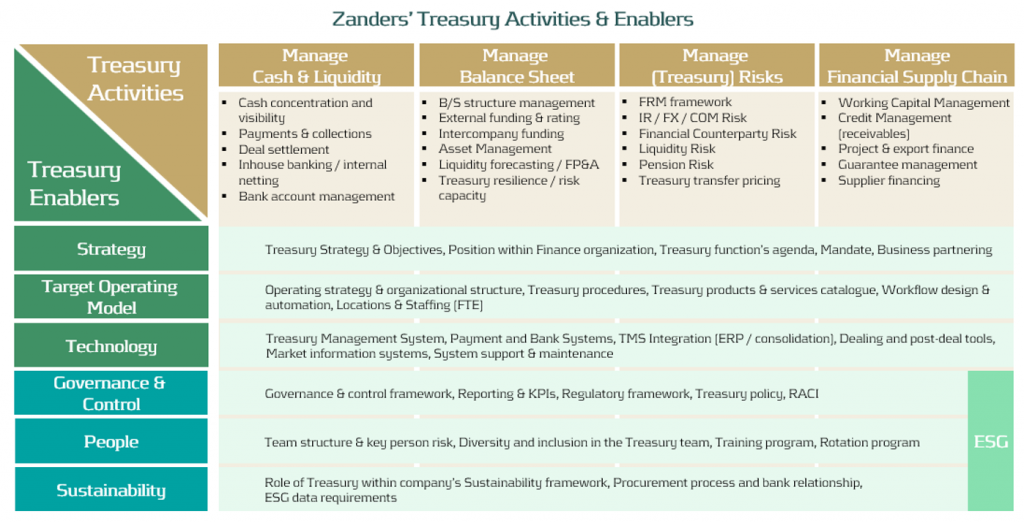C. Steinweg Group is a market-leading logistics and warehousing company with over 6,250 employees and warehouses and terminals that span more than 100 locations in 55 countries worldwide. With 175 years plus experience of storage, handling, forwarding and chartering services throughout the world, the company is a renowned and respected logistics partner for the global commodity trade.
Over its long history, Steinweg has demonstrated agility and resilience, responding to market challenges through innovating its approach to logistics and warehousing services and showing relentless commitment to customer services. Over the years, the business has also diversified into commodity financing as an added value service to its logistics and warehousing activities. At the end of 2022, the company appointed Zanders to advise them on the refinancing of two debt facilities. The aim was to provide the business with the robust and flexible access to capital they needed to continue to support, scale and grow their international operations.
The refinancing project comprised of two core requirements:
- The refinancing of Steinweg’s group credit facility.
- A new, more flexible credit facility for the commodity finance subsidiary.
Due to an overlap in the counterparties invited to participate in the two transactions, Steinweg saw the efficiency potential of taking both of the transactions to market simultaneously. But this also added complexity in terms of arranging and managing the refinancing process and procedures.
It was not a standard refinancing
Pim Van Der Heijden, C. Steinweg Group

“There was a certain complexity to this project, because the refinancings were interrelated from various perspectives,” says Pim Van Der Heijden, Steinweg’s group treasurer and global head of commodity finance. “It was not a standard refinancing. Especially the commodity financing activity, where we didn't go for just a straightforward, typical trade financing credit facility. We were putting something in place which was not only new for us but also for lenders and the legal counsels involved—we had to get them a little bit out of the comfort zone.”
Steinweg recognised early that they would need external support from a debt advisor to help get banks on board with this more innovative structure and also to optimize the value they would get from the refinancing process as well as adding capacity to the team. Zanders had previously worked with Steinweg when its group credit facility was first renewed in 2017, and this experience contributed to the appointment of Zanders to assist them with the new refinancing transactions.
“We approached a few advisors, but we selected Zanders based on track record and pricing,” Van Der Heijden adds. “We know Zanders and we had a good relationship with them, so we had confidence that they could deliver what we were looking for.”
Advice grounded in robust understanding of market practice
As well as their history and established relationship with Steinweg, it was also Zanders’ experience in the market that influenced their appointment on this project. Whereas a company will go to the market every five or seven years to refinance facilities, Zanders is continuously working with lenders on these transactions. This empowers them with current know-how on market practice regarding terms and pricing. Steinweg recognized the value this could bring to their process.
“It really helps to have a debt advisor who has insights into what's happening in the market, what is possible and what is not possible based on actual transactions—they understand how banks work and what is achievable,” Van Der Heijden says. “When Zanders came up with this alternative structure for the commodity financing facility, there was a certain amount of risk involved with going forward with it. This was however one of the reasons that we started the process early, this gave us time to sound and refine the structure. In addition, we knew that we were in good hands, and we ended up getting the results we wanted from it in terms of gaining flexibility that previously wasn't available and might not have been available with a more conventional approach.”
With the maturity of the group credit facility looming in July 2024, this transaction was mission critical and the driving force behind the timing of the combined refinancing project.
“We wanted to start early, and we set the goal to have the new group financing in place before the end of the year 2023,” says Van Der Heijden. “We started preparing by selecting Zanders as a debt advisory partner at the end of 2022, ready to start the process in early 2023, leaving time to complete the transaction by the end of that year.”
A resilient process
The process started with Zanders sitting down with Steinweg to discuss their objectives and requirements for the refinancing. Various scenarios were then modelled before finalizing the structure and characteristics of the new facilities. The RFP documents were then issued to the group of banks identified as a good match. In this case, six banks were invited to pitch—Steinweg’s existing lenders and a selection of additional lenders that matched the required criteria. Zanders’ attention then turned to collecting responses and creating term sheets for the new credit facilities, starting with the group financing.
When it comes to refinancing processes, it’s always wise to prepare for all scenarios. In this case, particularly given the progressive structure of the new facilities, it was important to be prepared for the eventuality that a lender could opt to exit the process. For this reason, more banks than strictly required were invited to participate.
“The new structure was a bit off the beaten track and while we were keen to push new boundaries, we had to be prepared for the reality that some lenders might not share our enthusiasm,” remembers Van Der Heijden. “This approach paid off when an existing lender decided not to participate. Rather than unsettling the process, instead it served to reassure us that the strategy to include more than just our existing bank in the process was good. And it all worked out.”
Due to the highly structured approach and extensive project set-up, when changes occurred there were provisions in place to ensure they caused minimal disruption to the process. This approach ultimately enabled Steinweg to secure competitive pricing and terms for their new group facility. And importantly, this was achieved comfortably ahead of the deadline set by the maturity of their previous agreement.
While the two financing processes ran in parallel, due to the impending maturity of the group facility, securing this was the primary focus initially. Once the group facility was agreed, attention shifted to the commodity financing facility. Steinweg was looking to increase their credit facility, to give them scalable access to more flexible funding to finance commodities on behalf of its clients. Previously, bilateral loan agreements were used to fund this aspect of the business leading to funding inefficiencies. “We had some goals we wanted to achieve with this new funding structure,” says Van Der Heijden. “The most critical was, of course, securing scalable financial headroom, but flexibility was almost as important.”
To deliver this more scalable and flexible access to credit, Zanders modelled a facility that allowed multiple banks to provide funding for commodity financing under the same loan. As an atypical arrangement, it required Zanders to work closely with each counterparty to gain their support for this novel structure.
“The new structure was relatively off the beaten track, but it provided what we needed, which is a lot of flexibility,” says Van Der Heijden. “And the flexibility it gives us is now paying off daily. We can now have three banks participating in a loan and other banks can also be added to the structure as well.”
Reaping the benefits
The new commodity financing facility not only provides essential access to more sources of funding, but also enables Steinweg to react quicker to opportunities and deliver faster, more seamless commodity financing solutions to its customers.
“The group facility was a lifeline, whereas the credit facility for the commodity financing activities was more of a ‘nice to have’ but now it's really adding value in terms of enabling us to pursue growth,” says Van Der Heijden. “We no longer have to talk to our lenders every time we go to market and that really pays off. Previously, if we had a new commodity financing prospect, we sometimes had to wait two weeks to get an answer from our banks to see if we can use the funding. Now, as long as we’re comfortable that it's within the pre-agreed rules, we can pretty much reply to them the same day.”
Conclusion
This project was not only strategically critical for Steinweg but also represented a bold departure from their existing financing agreements. With Zanders’ guidance, they were able to pursue this ambitious approach with confidence and conclude both of the refinancing projects before the end of 2023. This gave the team the peace of mind that their funding was agreed well ahead of their group facility maturing.
This project underscores the value of having an independent debt advisor to navigate your company through the complexities of structuring credit facilities. From ensuring essential deadlines are achieved and developing innovative structures to maintaining the momentum for the process and securing the most beneficial terms with banks. For more information on Zanders' debt advisory and refinancing expertise, contact Koen Reijnders and visit our Corporate finance page.




















































